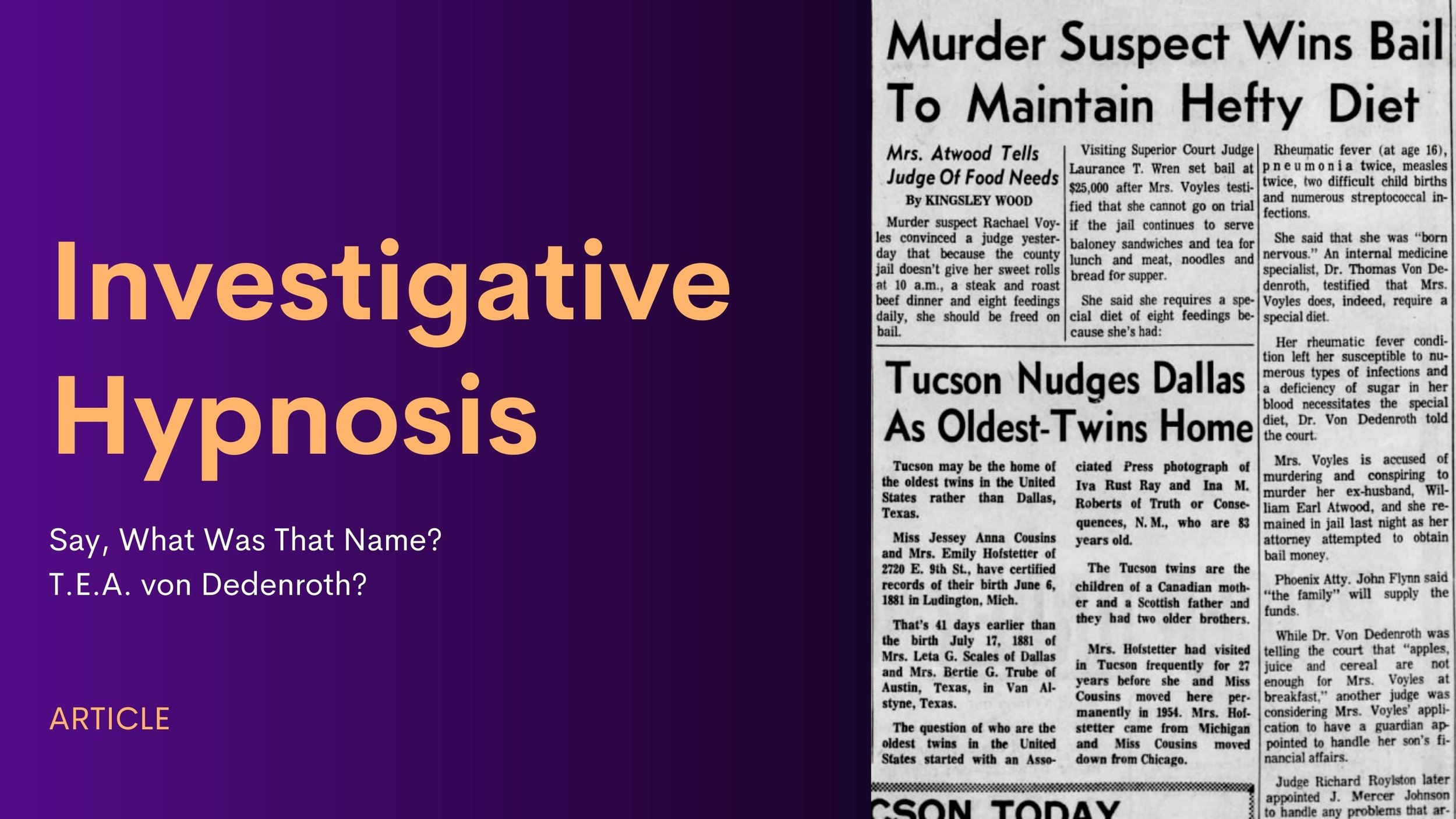Investigative Hypnosis - Pt. 2
Say, What Was That Name? T.E.A. von Dedenroth?
Written By Joyce Bavlinka, M.Ed., LISAC
Estimated Reading Time: 7 minutes, 39 seconds
While sorting through the Foundation’s book collection, I came across several books that were autographed by Erickson. Two of the three autographed books we found were autographed to T.E.A. von Dedenroth. The name intrigued me, as well as Erickson’s quirky messages. Who was T.E.A. von Dedenroth and how was he a part of Erickson‘s story?
I had never heard the name and not much has been written about him and his association with Erickson. T.E.A. was an internist from Tucson and because of his work with Erickson became a forensic psychiatrist. T.E.A. was also one of Erickson’s physicians. As a forensic psychiatrist, T.E.A. testified as an expert witness in some very, very interesting cases. If he were alive today, he would likely have a significant number of followers on Facebook and Instagram.
FIRST ERICKSONIAN CONFERENCE AND ERICKSON’S AUTOGRAPH
At the first Erickson Congress in 1980, [Erickson Foundation: IC80-General Session 03, Audio only] T.E.A. starts his presentation saying he knew Erickson as a dedicated teacher, as a colleague, as a friend, and as Erickson’s physician. He claims Erickson was his most difficult patient. He says Erickson resembled a “walking book of pathology.” Attempting to deal with his mind was like petting a cobra.” He compares Erickson’s life to “licking honey from a thorn.”
T.E.A. describes Erickson’s approach with patients:
“he conveyed the idea that a person came to be helped, and that he could help them and he only ask them to do what he knew they could do. And wouldn’t they let their subconscious mind be their guide? And in a few words, he was able to mobilize their thoughts, stimulate their imaginations, assure them of personal help, reinforce their faith and hope. And then apply the coup-de-gras with double binds…. He paid attention to the most painstaking details which are frequently not obvious to others observing him and very often least obvious to the patient.”
“He would have them follow exactly what he said, and then, wind up saying something totally unexpected by the patient so they would not follow what they thought they were following… because they couldn’t follow what they thought he said…. Confusing??? ….. not at all.”
He tells of how Erickson autographed his copy of “Patterns of Hypnotic Techniques of Milton H. Erickson, M.D. Volume 2”, Grinder, DeLozier, and Bandler, 1977. This book is held in the Erickson Foundation archives.
To T.E.A. von Dedenroth, M.D.
I plead guilty to the charge that
I caused a certified internist to
become a cynical psychiatrist and
to become a critical forensic
psychiatrist but I emphatically
claim absolute innocence in the
matter of your growing hair upon
your face instead of upon your head.
March 1978 Milton H. Erickson, M.D.
After sharing his personal experiences with Erickson and his description of Erickson’s methods, he went back to the theme of the workshop, addictive smoking, which he describes as tobaccomania. “The Treatment of Tobaccomania: a hypnotherapeutic method of smoking control,” was first published in the April 1964 issue of the American Journal of Clinical Hypnosis. The article was also published as Appendix A in “Thanks Doctor, I’ve stopped Smoking, a modern doctor-patient approach to smoking control,” by Kroger, W. S., and Libott, R. Y. This book is part of the Erickson Library collection.
T.E.A. developed a twenty-one-day program with four in-person visits. He reviews the patients smoking history, their desire to stop smoking and sets a quit date. He asks the patient to change from his favorite brand to another and not to smoke before breakfast: he reinforces these suggestions with hypnosis. He suggests that while the first puff on a cigarette will be enjoyable, “the second will be rather unpleasant. The third will be irritating to the nose, or bronchial tubes….” He claims that 48 of the group of 50 smokers stopped smoking.
MORE ABOUT T.E.A.
Following are some ‘fun facts’ about T.E.A. He was always referred to by his initials, but Erickson referred to him as ‘Von’ and at other times as Ted. We recently found out that his full name was Thomas Edward Asklow von Dedenroth. He was born in 1925 and died in 1990. He graduated from Jefferson Medical College in June 1949 and became licensed in Arizona in August 1951; he maintained a practice as an internist in Tucson. The El Conquistador Hotel hosted the first Medical School Alumni meet for the state of Arizona in Tucson in 1959. The Jefferson Medical College Alumni Newsletter recounts that “We all had cocktails from 4:00 pm to 6:00 pm and at 6:00 pm retired to the dining room where we ingested excessive calories and enjoyed each other’s company.” T.E.A. was elected the state chapter chair. The article appears in the Jefferson Alumni Bulletin, Volume 41, #2, May 1959, p. 36-37.
AS A HYPNOTHERAPIST
He was involved in a variety of cases where he either used hypnosis to refresh a witness’s memory, to help a patient in a high-risk medical case with pain control, and in other cases as an internist. A search on newspapers.com brings up the following articles.
The June 4, 1965, edition of the Phoenix Gazette reports Phoenix police narrowed their search for a hit-and-run car that killed a child in central Phoenix. Under hypnosis with T.E.A., the witness was able to remember details of the car and that the license plate included the letters J and N: police were able to track down the driver.
T.E.A. provided hypnotherapy to one of the patients in an experimental cancer treatment case. The case made national news and was published in more than 75 papers. The Bridgeport Post reports in the May 9, 1996 edition, the death of Robert Allen, an ex-high school football player from Tucson. Allen, suffering from a rare form of bone cancer, underwent a transfer of cancerous tissue from another patient suffering from the same malady. “Specialists hoped the transfer of cancer tissue would produce antibodies in the blood of both men and help stop the spread of cancer.” Both men were terminally ill and had a short time to live: unfortunately, both men died shortly after the operation. T.E.A. provided hypnotherapy to Allen and it is reported the patient was hopeful till the end.
TESTIFYING AS AN INTERNIST AND AS A FORENSIC PSYCHIATRIST
The Arizona Daily Star, September 2, 1967, reports “Murder Suspect Wins Bail to Maintain Hefty Diet.” This was a case where a woman was being held without bail after being charged with murdering her wealthy industrialist ex-husband. According to her, she went to the ex-husband’s house to get financial support for their disabled son. Although von Dedenroth was not mentioned during the trial, he testified on her behalf at her bail hearing. The woman said that “since the county jail doesn’t give her sweet rolls at 10:00 am and a steak and roast beef dinner and eight feedings a day, she should be freed on bail.” She ultimately was released on $25,000 bail after von Dedenroth testified that she required a “special diet of eight feedings per day because of prior sicknesses and health conditions. She said she “could not go to trial if the jail continues to serve baloney sandwiches and tea for lunch and meat, and noodles and bread for dinner.”
In another case, T.E.A. testifies for the plaintiff in a case involving a breach of contract. A stunning German woman sued a wealthy part-time Arizona rancher for $2.5 million for breach of contract, contending that the defendant promised to marry her and set up a $1.5 million trust fund for her if she divorced her husband and married her. The plaintiff presented over one hundred “love letters” and the defendant maintained that it was a man-mistress affair and that there was no promise of marriage. The plaintiff and her husband met the defendant at a nudist resort in northern Germany. The finding was for the defendant. The story was reported in the February 24, 1967, edition of the Post-Standard in Syracuse N. Y.
HIS TUCSON OFFICE TODAY
There seems to have been a bit of a flare for drama in my investigation of T.E.A. His involvement with unique cases and testimony at various trials seems to have also followed the location where he practiced.
T.E.A. maintained his practice at 1800 East Speedway in Tucson, Arizona. For the last three decades, the building has housed a bar named Dirtbags. According to their website, dirtbagsbar.com “a gathering place for University of Arizona fans before sporting events and a popular lunch spot for the surrounding community.” Regulars, known as Baggers, line up for events. It is like homecoming every week; their slogan is “After all, Dirtbags is part of growing up.”
This search for T.E.A. von Dedenroth lead me through the book collection at the Erickson Foundation Library, newspapers.com, the annals of the Jefferson Medical School, and to historians at the University of Arizona and the Tucson Historical Society. T.E.A. proved he had as interesting a career as his name.
I have completed further research and will be doing a follow-up blog post on T.E.A. If you knew T.E.A. von Dedenroth or have any information about him, please email: joyce@erickson-foundation.org
I would like to put together a blog post of Erickson’s autographs. If you have any books autographed by Erickson and would like to share them, please email me with the details at: joyce@erickson-foundation.org
You might like…




